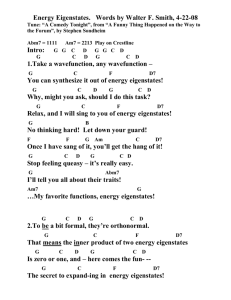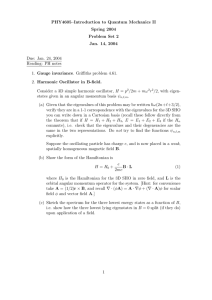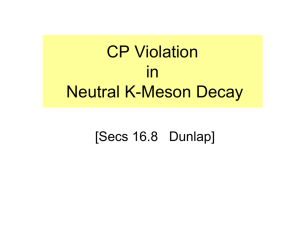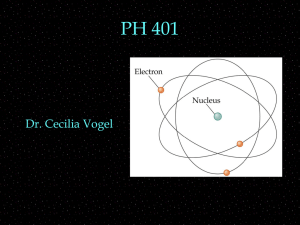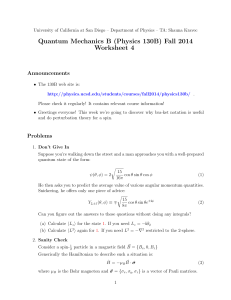Local Conservation Laws and the Structure of the Many- Please share
advertisement
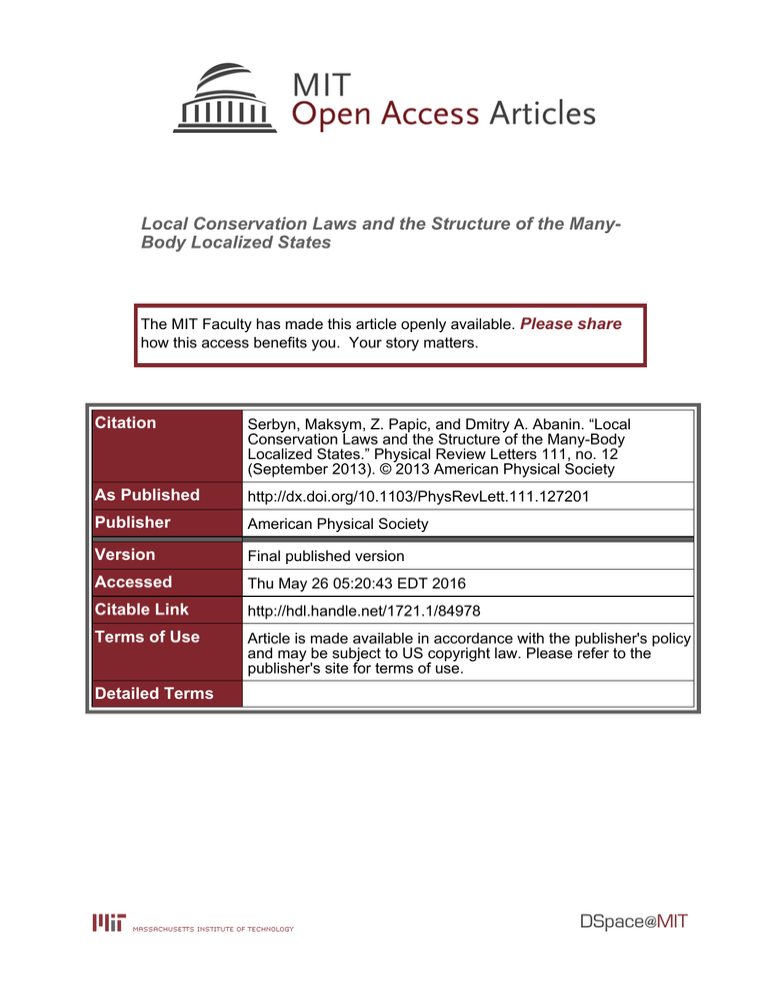
Local Conservation Laws and the Structure of the ManyBody Localized States The MIT Faculty has made this article openly available. Please share how this access benefits you. Your story matters. Citation Serbyn, Maksym, Z. Papic, and Dmitry A. Abanin. “Local Conservation Laws and the Structure of the Many-Body Localized States.” Physical Review Letters 111, no. 12 (September 2013). © 2013 American Physical Society As Published http://dx.doi.org/10.1103/PhysRevLett.111.127201 Publisher American Physical Society Version Final published version Accessed Thu May 26 05:20:43 EDT 2016 Citable Link http://hdl.handle.net/1721.1/84978 Terms of Use Article is made available in accordance with the publisher's policy and may be subject to US copyright law. Please refer to the publisher's site for terms of use. Detailed Terms week ending 20 SEPTEMBER 2013 PHYSICAL REVIEW LETTERS PRL 111, 127201 (2013) Local Conservation Laws and the Structure of the Many-Body Localized States Maksym Serbyn,1 Z. Papić,2 and Dmitry A. Abanin3,4 1 Department of Physics, Massachusetts Institute of Technology, Cambridge, Massachusetts 02138, USA 2 Department of Electrical Engineering, Princeton University, Princeton, New Jersey 08544, USA 3 Perimeter Institute for Theoretical Physics, Waterloo, Ontario N2L 2Y5, Canada 4 Institute for Quantum Computing, Waterloo, Ontario N2L 3G1, Canada (Received 5 June 2013; revised manuscript received 10 July 2013; published 17 September 2013) We construct a complete set of local integrals of motion that characterize the many-body localized (MBL) phase. Our approach relies on the assumption that local perturbations act locally on the eigenstates in the MBL phase, which is supported by numerical simulations of the random-field XXZ spin chain. We describe the structure of the eigenstates in the MBL phase and discuss the implications of local conservation laws for its nonequilibrium quantum dynamics. We argue that the many-body localization can be used to protect coherence in the system by suppressing relaxation between eigenstates with different local integrals of motion. DOI: 10.1103/PhysRevLett.111.127201 PACS numbers: 75.10.Pq, 05.30.Rt, 64.70.Tg, 72.15.Rn Introduction.—Localization of eigenstates of a single particle in the presence of disorder is among the most remarkable consequences of quantum mechanics. Although the single-particle localization and localizationdelocalization transition are well understood [1,2], much less is known about the nature of the eigenstates in interacting many-body disordered systems. The interest in the problem of the many-body localization was rekindled when recent works [3,4] suggested that the localized phase is stable with respect to weak interactions. This conjecture was also corroborated by numerical studies [5–16]. In the noninteracting localized phase, dynamics is simple because any initial wave function can be decomposed into a superposition of localized single-particle eigenstates. However, when interactions are introduced, the dynamics becomes notably richer [7,16–18]. Although particle transport is still expected to be blocked, the time evolution of initial product states in the interacting localized phase generates a universal slow growth of entanglement entropy [17]. Saturated entropy was established to be proportional to system size [7,16–18], and such growth of the entanglement was argued to reflect ‘‘partial thermalization’’ of the system. However, the type of the ensemble describing the many-body localized (MBL) phase is unknown. On the experimental side, probing the dynamics of interacting disordered systems has become feasible due to the advances in the field of ultracold atomic gases [19,20]. In particular, nearly isolated quantum systems of cold atoms can now be engineered, prepared in a variety of initial states (including product states [21]), and studied during their subsequent time evolution. These opportunities call for developing a better understanding of the laws that govern the dynamics in the MBL phase. Here we consider a many-body system whose eigenstates at all energies are localized, and show that they 0031-9007=13=111(12)=127201(5) can be characterized by a large number of emergent local integrals of motion corresponding to multiple local conservation laws. These integrals of motion form a complete set, in the sense that their values completely determine the eigenstates. Local conservation laws strongly constrain the quantum dynamics in the MBL phase, preventing a complete thermalization of any given subsystem. Any initial state can be decomposed in terms of the eigenstates possessing definite values of the integrals of motion. During time evolution, the weights of different states cannot change. However, because of the exponentially weak interaction between distant degrees of freedom, the relative phases between the states with different values of local integrals of motion become randomized. Any local observable at long times is therefore determined only by the set of probabilities of local integrals of motion that affect the degrees of freedom in the region where the observable is measured. We refer to this as the local diagonal ensemble. The dephasing due to the interactions between distant subsystems is a distinct feature of the MBL phase compared to the noninteracting one, and underlies the slow growth of entanglement [16,17,22,23]. Integrals of motion.—First, we note that for the noninteracting case the local integrals of motion are simply given by I^i ¼ cyi ci , where cyi creates a localized singleparticle state. For fermions, the possible eigenvalues of this integral of motion are Ii 2 f0; 1g. In a system with K orbitals, there are 2K eigenstates, which are uniquely labeled by the eigenvalues of K integrals of motion. In order to explicitly construct local integrals of motion for an interacting system, we assume the following property of the localized phase: local perturbations lead only to local modifications of the eigenstates in the MBL phase. That is, if we act on a MBL eigenstate with a local perturbation, introduced either adiabatically or instantaneously, the degrees of freedom situated at a distance L 127201-1 Ó 2013 American Physical Society PRL 111, 127201 (2013) (here is the localization length [24]) away from the support of the perturbation operator, are generally affected exponentially weakly. We will support this statement below by the numerical study of the random-field XXZ chain, also considered in Refs. [7,10,12,15,16]. Let us consider a MBL system described by a local Hamiltonian, and let us divide it into subsystems of size l . Without loss of generality, we consider a 1D system, although our conclusions apply to localized phases in any number of spatial dimensions. We number the subsystems by i ¼ 1; . . . ; N from left to right, assuming the number of degrees of freedom M in each subsystem is the same (e.g., for K spins, M ¼ 2K ). For the fixed subsystem i, we denote parts of the full system to the left and to the right of i by Li and Ri , respectively. The Hamiltonian can be written as H ¼ HL þ Hi þ HR þ HLi þ HRi ; (1) where HL , HR , Hi act only on the degrees of freedom in L, R, i, while HLi , HRi couple L, i and R, i. If the subsystems L, i, R are disconnected from each other (i.e., HLi , HRi are set to zero), the eigenstates are simple products: ji0 ¼ jiL jii jiR , where 2 f1; . . . ; Mi1 g, ¼ f1; . . . ; Mg, ¼ f1;...;MNi g. Once the subsystems are connected, the eigenstates of the full Hamiltonian (1) are obtained from the product states ji0 by nearly local rotations. We label the resulting eigenstates by their ‘‘ancestors,’’ omitting the ‘‘0’’ subscript, ji ¼ O^ Li O^ Ri jiL ii jiR : M X ¼1 i1 MNi M X X jihj: i.e., it weakly affects the degrees of freedom in L or R at a distance x away from the boundaries with the ith subsystem. The locality of I^i follows directly from the locality of operators O^ Li , O^ Ri , which implies that the sum of projectors becomes very close to the identity operator far away from the boundaries. Below, we will test the locality of the operator in Eq. (3) in a specific model. Having defined the integral of motion for the subsystem i, we can similarly define N 1 integrals of motion for the remaining N 1 subsystems, such that in total we have N integrals I^i , i ¼ 1; . . . ; N. Different I^i commute with each other ½I^i ; I^j ¼ 0 since they are sums of projectors onto the exact eigenstates of the full system. Each I^i has M possible eigenvalues; thus, the full description of the system via integrals of motion requires MN parameters, which coincides with the dimensionality of the Hilbert space. An operator I^i can also be viewed as the z component I^i ¼ S^iz of a ‘‘spin’’ S ¼ ðM 1Þ=2. Raising and lowering operators can then be used to construct the entire set of eigenstates, starting from any given eigenstate jI1 I2 . . . IN i characterized by the integrals of motion I1 ; I2 ; . . . ; IN . Therefore, specifying the eigenvalues of all integrals of motion defined above completely determines the eigenstates of the system. Hamiltonian and its relation to integrals of motion.— The Hamiltonian takes an especially simple form when written in terms of the integrals of motion: H¼ (2) Operator O^ Li is a unitary many-body rotation which strongly transforms only the degrees of freedom within a distance away from the boundary between L and i (similarly for O^ Ri ). The commutator of O^ Li and O^ Ri , as well as the action on the degrees of freedom far away, decays exponentially. We note that the assignment (2), which links the eigenstates of the system to the eigenstates of subsystems, is not unique, and assume that a certain one-to-one correspondence is chosen. We now define the integral of motion for subsystem i I^i ¼ week ending 20 SEPTEMBER 2013 PHYSICAL REVIEW LETTERS (3) ¼1 ¼1 Being a linear combination of projectors onto the exact eigenstates, I^i necessarily commutes with the Hamiltonian and assumes eigenvalues 1; . . . ; M. Intuitively, states with the same eigenvalue of I^i look nearly identical within the subsystem i at distances larger than away from the boundaries with subsystems L, R. Sums of projectors onto the eigenstates are integrals of motion by construction; however, generally such operators are nonlocal and affect all degrees of freedom of the system. The operator in Eq. (3) is special in that it is local; N X M X i I1 ¼1 þ N X EIi P^ iIi þ M X i<j<k Ii ;Ij Ik ¼1 N X M X ij Ii ;Ij ¼1 EIi Ij P^ iIi P^ jIj EIi Ij Ik P^ iIi P^ jIj P^ kIk þ ; (4) where P^ iIi is the projector onto the subspace for which the eigenvalue of the ith integral of motion is equal to Ii . In the above equation, EIi can be roughly viewed as the energy of the ith subsystem for the sector Ii , EIi Ij is the interaction energy between i and j subsystems, etc. There are interactions between any given n subsystems; however, they are exponentially small. Generally, we expect that energies EIi are proportional to l, the size of the subsystems. EIi Ij are proportional to when i ¼ j 1, and are suppressed as elðjijj1Þ= otherwise (the interactions between the neighboring subsystems are limited to the boundary and are therefore proportional to ). The above representation of the Hamiltonian gives us a way to describe the dynamics in the MBL phase for various kinds of initial states [7,10–12,16,17]. Dynamics.—As a first step, we consider the dynamics of an eigenstate which is perturbed locally. We assume a sudden action of the local unitary operator U^ on the eigenstate j0 i ¼ jI1 I2 . . . IN i. Operator U^ acts only on the degrees of freedom in subsystem 1, and its support is 127201-2 PHYSICAL REVIEW LETTERS PRL 111, 127201 (2013) situated far from the boundary between subsystems 1 and 2. The initial wave function jðt ¼ 0Þi can be decomposed in terms of the eigenstates: X ^ 0 i ¼ UI I0 jI10 I2 . . . IN i þ : jðt ¼ 0Þi ¼ Uj (5) 1 1 I10 This form of the decomposition is dictated by the fact that the values of the integrals of motion I2 ; . . . ; IN can be changed only with an exponentially small probability; hence, the terms with other values of I2 ; I3 ; . . . in Eq. (5) are represented by ellipses. Neglecting these terms, the subsequent dynamics becomes trivial: X iE 0 t jðtÞi ¼ UI1 I10 e I1 I2 ...IN jI10 I2 . . . IN i; (6) I10 where EI10 I2 ...IN is the energy of the state jI10 I2 . . . IN i. Generally, we expect a finite number of different I10 which have significant matrix elements UI1 I10 , typically comparable to the dimensionality of a subsystem of size . Therefore, the time evolution (6) describes coherent oscillations that involve a finite number of states. Any local observable in region 1 would therefore oscillate at a number of frequencies, showing revivals but no dephasing. This situation changes if the state j0 i is not an eigenstate, but a superposition of several eigenstates which involve different values of I2 ; I3 ; . . . ; Ik . In this case, exponentially slow dephasing arises, suppressing the revivals and oscillations of local observables in the long-time limit. The values of observables at long times are determined by the probabilities jUI1 I10 j2 . Second, we describe the global evolution of states which differ from the eigenstates everywhere, not just locally. For definiteness, consider an initial product state of subsystems 1; 2; . . . ; N: X M ji ¼ N A j i (7) i i ; i¼1 i ¼1 where ji i is an eigenstate of the Hamiltonian Hi . Modern experimental techniques allow for the preparation and manipulation of such states in optical lattices [21]. Each component N i¼1 ji i of the product state (7) can be related to the eigenstate of the whole system, jI1 I2 . . . IN i, by the set of local rotations acting near the boundaries between different subsystems. The dynamics corresponding to this effect will be limited to the boundaries between pairs of subsystems. However, for each wave function, degrees of freedom at a distance x away from the boundary will remain undisturbed. Such dynamics therefore does not generate long-range entanglement. More importantly, since we are dealing with a superposition of different product states N i¼1 ji i, the degrees of freedom in the subsystem i will be in a superposition of states with different values of the integral of motion Ii . Different states entering this superposition are eigenstates; week ending 20 SEPTEMBER 2013 therefore, their relative weights cannot change under time evolution. However, their phases will become random due to the interactions with distant subsystems, as is evident from the Hamiltonian (4). Such dephasing, though exponentially slow, will produce long-range entanglement, and thus give rise to the entanglement entropy that is extensive in the system size and determined by the participation ratios of different eigenstates [25], as discussed in detail in Ref. [16]. Numerical simulations.—Although our construction is general, we now test the validity of our basic assumption using exact diagonalization of a particular model—the random-field XXZ spin chain. We consider a chain of L spins with open boundary conditions, exchange J? ¼ 1, and interaction strength Jz ¼ V, while the random onsite magnetic field is uniformly distributed in the interval W. The total z component of the spin is conserved, and calculations are restricted to the Sz ¼ 0 sector. For V ¼ 0 the model is equivalent to free fermions with disorder, and all states are localized. Because of the limits on the accessible system sizes in exact diagonalization, we restrict ourselves to the case of the symmetric bipartite division of the full system LR into the left (L) and right (R) half. First, we study the averaged entanglement entropy Sent of the L subsystem in the eigenstates of LR, illustrated in Fig. 1(a). For strong disorder, Sent saturates to a value of the order 1 with increasing system size, indicating short-range entanglement in the MBL eigenstates, which is consistent with our basic assumption. Next, we use the inverse participation ratio (IPR) as an intuitive, albeit somewhat indirect, test of the locality of operators O^ Li from Eq. (2), which, when acting on products of eigenstates of systems L, R, give eigenstates of LR. The IPR for some state Pji over a complete basis ji i is defined as IPRðjiÞ ¼ ð p2i Þ1 , where pi ¼ jhji ij2 represents the probability of finding a state ji i. Defined in such a way, the IPR takes values between 1 and the Hilbert space dimension, and effectively tells us how many FIG. 1 (color online). (a) Averaged entanglement entropy is of the order 1 and varies weakly with L for strong disorder, indicating that eigenstates are short-range entangled. Interaction strength is V ¼ 1. (b) Inverse participation ratios for the product of two eigenstates of the L and R subsystems are close to 1 and do not depend on L for strong disorder. 127201-3 PRL 111, 127201 (2013) PHYSICAL REVIEW LETTERS components have nonzero weight in the decomposition of the given state over the chosen complete basis. Figure 1(b) shows the average IPR for the product ji ji of two random eigenstates of the L and R subsystems over the eigenstates ji of LR. The value of the IPR at strong disorder is very close to 1, indicating that the product of eigenstates of L and R is ‘‘close’’ to the eigenstate of the full system LR. Furthermore, the IPR does not grow with L for strong disorder, suggesting that the product of eigenstates of L and R differs from the eigenstate of the full system only near the boundary. To provide further support for our construction of the integrals of motion, we numerically implemented the projector operator similar to the one defined in Eq. (3). Every eigenstate ji of LR is labeled by its ‘‘ancestor’’ in L as in Eq. (2). To find the ancestor, we calculate the density matrix ^ for the L subsystem from ji. Using ^ , we extract the probabilities of all eigenstates of L as p ¼ jhj^ jij2 . In the limit of very strong disorder the typical value of the largest p is close to 1 [26]. Thus, the ‘‘ancestor’’ for ji is defined to be an eigenstate of L with the largest probability p . Although we do not assign labels for the right subsystem, such labeling is sufficient to implement the operator P P^ ¼ P^ as a projector onto the subspace of all eigenstates with the same label for the L. As a simple test, we study the locality of the projector P^ : by construction it must have trivial action in the right subsystem. To test this property, we perturb some eigenstate with label , j i, at the right boundary j c i ¼ ð1=2 þ 2SL SL1 Þj i. Because we are interested in the weight of j c i in the subspace with the same label , we plot the averaged h c jP^ j c i as a function of disorder in Fig. 2. For strong disorder, even when the interaction strength is V ¼ 1, the perturbed state j c i has almost all of its weight in the subspace with index , indicating that the degrees of FIG. 2 (color online). The weight of the perturbed eigenstate j i in the subspace with index . For strong disorder, the action of the projector is contained within the subspace , irrespective of the interaction: the case of no interaction V ¼ 0 is shown in (a), and V ¼ 1 in (b). The weight increases with system size. For weak disorder (W < 3), the presence of interactions causes the weight to decrease with the system size, suggesting the onset of the delocalized phase. week ending 20 SEPTEMBER 2013 freedom in the subsystem L are not affected by the perturbation acting on the subsystem R. It is evident from Fig. 2(b) that the weight within the subspace grows as a function of system size at W > W , and decreases at W < W , where W 3. Thus, W gives an estimate of the MBL transition location in agreement with Ref. [10]. We note that the construction described above allows for more explicit tests to be done, which will be presented in future work [27]. Additional numerical verifications of our central assumption can be found in Ref. [26]. Discussion.—We established that the MBL phase is characterized by a number of local integrals of motion, supporting the hypothesis put forward in Ref. [18]. This implies that the MBL phase does not thermalize, and only partial thermalization of initial product states, constrained by the local conservation laws, is possible. It should be noted that there are many ways to define local integrals of motion. For example, in certain problems [28] it might be helpful to label the integrals of motion by a set of 1=2 pseudospins. Then, M ¼ 2K possible values of a given integral of motion I^i can be viewed as states of K pseudospins i , ¼ 1; . . . ; K. The z projections of these pseudospins form a complete set of integrals of motion, and the Hamiltonian only involves iz operators and their products. Operators i can be viewed as effective degrees of freedom, in terms of which the dynamics becomes trivial: up-down states of spins are eigenstates, so time evolution can only lead to the dephasing between them. Another implication of our work concerns the structure of the MBL eigenstates: they are short-range entangled, obey the area law, and can be generally represented as a product of eigenstates of the subsystems of size which have been locally ‘‘corrected’’ near the boundaries with neighboring subsystems. This suggests an efficient numerical procedure for describing the MBL eigenstates in terms of matrix-product states. Starting from the product of eigenstates of decoupled blocks of size , entanglement between the blocks is introduced by the repeated action of the boundary terms in the Hamiltonian. The boundary terms generate only a finite-dimensional space; thus, diagonalizing the boundary Hamiltonian for each finitedimensional subspace, it should be possible to find the eigenstates of two coupled blocks, etc. Finally, our picture suggests a realistic route to extending coherence times in nearly isolated quantum systems, where decoherence is induced by interactions. Examples of such systems, in addition to systems of ultracold atoms, include nuclear spins and NV centers in diamond [29]. Assuming that one could induce strong static disorder leading to the many-body localization, the coherence time of a subsystem can be made very long. To achieve this, one needs to prepare a subsystem of size (e.g., subsystem 1 in the above example), as well as its immediate neighborhood (e.g., subsystem 2) in some eigenstate. Then, local operations on the subsystem’s degrees of 127201-4 PRL 111, 127201 (2013) PHYSICAL REVIEW LETTERS freedom would couple states with different integrals of motion I1 , but with fixed values of I2 . Therefore, even though the rest of the system is in some complicated superposition state, it will only give rise to an exponentially weak dephasing, with the rate proportional to expðl=Þ. We thank J. Moore for useful discussions. Research at Perimeter Institute is supported by the Government of Canada through Industry Canada and by the Province of Ontario through the Ministry of Economic Development & Innovation. Z. P. was supported by DOE Grant No. DESC0002140. M. S. was supported by the National Science Foundation under Grant No. DMR-1104498. The simulations presented in this article were performed on computational resources supported by the High Performance Computing Center (PICSciE) at Princeton University. Note added.—During the completion of this manuscript, we became aware of a related work [28] discussing the existence of local integrals of motion in the MBL phase. [1] P. Anderson, Phys. Rev. 109, 1492 (1958). [2] P. Lee and T. V. Ramakrishnan, Rev. Mod. Phys. 57, 287 (1985). [3] D. Basko, I. Aleiner, and B. Altshuler, Ann. Phys. (Amsterdam) 321, 1126 (2006). [4] I. V. Gornyi, A. D. Mirlin, and D. G. Polyakov, Phys. Rev. Lett. 95, 206603 (2005). [5] M. Rigol, V. Dunjko, V. Yurovsky, and M. Olshanii, Phys. Rev. Lett. 98, 050405 (2007). [6] V. Oganesyan and D. A. Huse, Phys. Rev. B 75, 155111 (2007). [7] M. Žnidarič, T. Prosen, and P. Prelovšek, Phys. Rev. B 77, 064426 (2008). [8] C. Monthus and T. Garel, Phys. Rev. B 81, 134202 (2010). [9] T. C. Berkelbach and D. R. Reichman, Phys. Rev. B 81, 224429 (2010). [10] A. Pal and D. A. Huse, Phys. Rev. B 82, 174411 (2010). week ending 20 SEPTEMBER 2013 [11] C. Gogolin, M. P. Müller, and J. Eisert, Phys. Rev. Lett. 106, 040401 (2011). [12] E. Canovi, D. Rossini, R. Fazio, G. E. Santoro, and A. Silva, Phys. Rev. B 83, 094431 (2011). [13] F. Buccheri, A. De Luca, and A. Scardicchio, Phys. Rev. B 84, 094203 (2011). [14] E. Cuevas, M. Feigel’man, L. Ioffe, and M. Mezard, Nat. Commun. 3, 1128 (2012). [15] A. De Luca and A. Scardicchio, Europhys. Lett. 101, 37 003 (2013). [16] M. Serbyn, Z. Papić, and D. A. Abanin, Phys. Rev. Lett. 110, 260601 (2013). [17] J. H. Bardarson, F. Pollmann, and J. E. Moore, Phys. Rev. Lett. 109, 017202 (2012). [18] R. Vosk and E. Altman, Phys. Rev. Lett. 110, 067204 (2013). [19] I. Bloch, J. Dalibard, and W. Zwerger, Rev. Mod. Phys. 80, 885 (2008). [20] A. Polkovnikov, K. Sengupta, A. Silva, and M. Vengalattore, Rev. Mod. Phys. 83, 863 (2011). [21] S. Trotzky, Y.-A. Chen, A. Flesch, I. P. McCulloch, U. Schollwock, J. Eisert, and I. Bloch, Nat. Phys. 8, 325 (2012). [22] F. Iglói, Z. Szatmári, and Y.-C. Lin, Phys. Rev. B 85, 094417 (2012). [23] G. D. Chiara, S. Montangero, P. Calabrese, and R. Fazio, J. Stat. Mech.: Theory Exp. 2006, P03001. [24] Localization length depends on the energy density, and should be viewed as the largest localization length. One may envision models where different excitations are characterized by different localization lengths. In this case as well, should be chosen as the largest localization length. [25] A. Polkovnikov, Ann. Phys. (Amsterdam) 326, 486 (2011). [26] See Supplemental Material at http://link.aps.org/ supplemental/10.1103/PhysRevLett.111.127201 for additional numerical tests and more details on the construction of the projector operator. [27] M. Serbyn, Z. Papić, and D. A. Abanin (to be published). [28] D. A. Huse and V. Oganesyan, arXiv:1305.4915. [29] L. Childress, M. V. G. Dutt, J. M. Taylor, A. S. Zibrov, F. Jelezko, J. Wrachtrup, P. R. Hemmer, and M. D. Lukin, Science 314, 281 (2006). 127201-5

